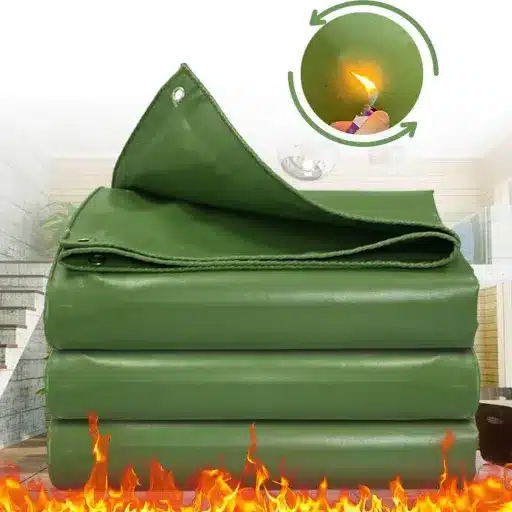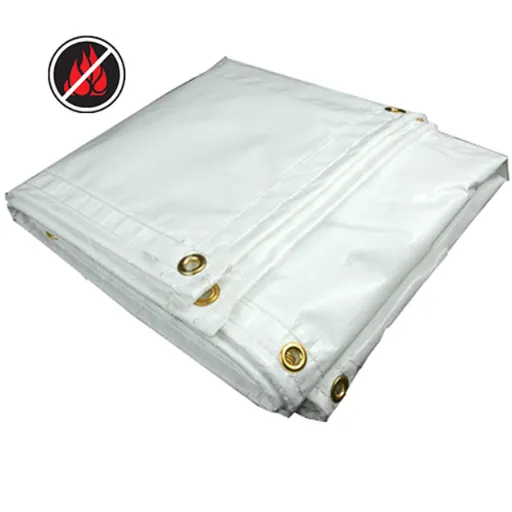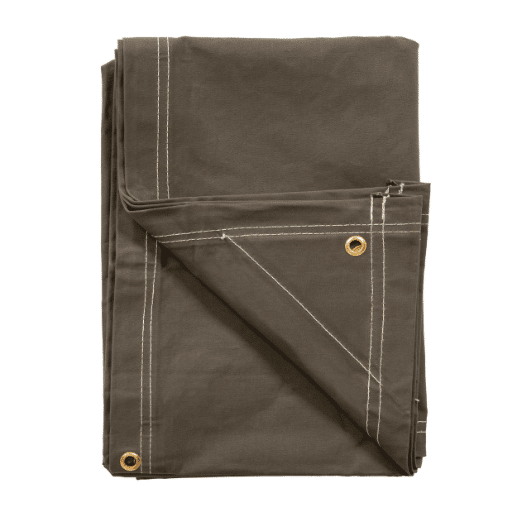When talking about heavy-duty tarps, the number one thing to take into account is the thickness. A tarp is made sturdier, or otherwise, depending on its thickness; therefore, the tarp’s capacity to go through rough weather conditions, heavy loads, and long-use hours depend highly on its thickness. Whether it’s tarps for construction purposes, industrial processes, or outdoor protection, one must know how the thickness of the tarp relates to the strength of the material and how it performs. This article sheds a deep insight into the meaning of ‘tarp thickness’ to help you make a more informed choice that addresses your need for sturdiness and long-lasting functionality. By the time you finish this article, your personal guide will be ready for heavy-duty tarps so that you have an investment that’ll meet all your expectations as well as the requirements of your intended application.
The Importance of Tarp Thickness
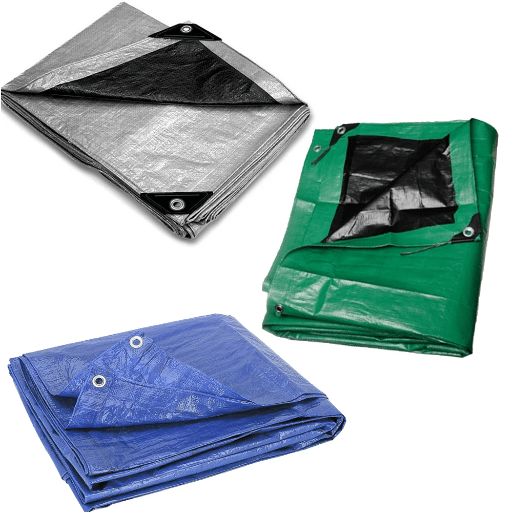
Tarp Thickness: A Key Factor in Its Performance
The thickness of tarps affects their durability, tensile strength, and resistance to various environmental factors such as UV, moisture, and abrasion. Tarp thickness, measured in mils (1 mil = 0.001 inches), is often the basic deciding factor in choosing one product over the other for any particular application. For example, for a 5-mil tarp, temporary light-duty applications might include covering items with dust indoors, whereas heavy-duty applications of tarp for covering equipment exposed to meteoric water must constitute 18 mils or more. Based on recent search trends, users seem to be opting more for thicker tarps for longer life against harsher conditions.
💡 Key Insight:
Advances in material engineering have led to innovations in producing thicker tarps that are still light in weight and have better protective properties. This trade-off comes in very handy for industrial and construction-based uses where identity is conferred juxtaposed with handling ease.
Fundamentally, the right choice of tarp thickness can only be made after fine analysis of all use conditions, how often the tarp is subjected to those conditions, and how important long-term performance is.
How Thickness Influences Strength and Durability
In deep consideration of the question of how thickness influences strength and durability, one must always bear in mind the kinds of materials being used along with the working environments for which tarp is employed. Since thicker tarps resist tear and puncture and withstand longer exposure to environmental stressors such as UV rays, wind, and heavy rain, recent data suggest that polyethylene tarps with thicknesses of about 10 to 12 mils are best for the construction site, being adequately rigid from extended use while being flexible. Conversely, thinner tarps of about 5 to 7 mils may be used to give temporary cover or do some light-duty work; however, under sustained stress, they are surely the weakest.
Thicker tarps also provide a much higher tensile strength than their thinner counterparts, making them suitable for harsher environments, including those involving heavy loads or abrasive surfaces. According to a search analysis trend, interest in reinforced poly tarps (more than 15 mils in thickness) has grown sharply among agricultural and industrial professionals, denoting their interest in steadfast solutions. Therefore, selection of tarp thickness should follow a systematic design integrating workload requirements, frequency of deployment, and exposure parameters to build on long-term strength and cost-effectiveness.
Applications Based on Tarp Thickness
Light-Duty Applications (Under 10 mils)
- Temporary weather protection
- Equipment cover for short-term projects
- Protection against light debris
- Residential or non-intensive professional setups
Medium-Duty Applications (10-15 mils)
- Semi-permanent agricultural coverings
- Machinery and hay bale protection
- Field equipment covering
- Moderate industrial uses
- Construction material covering
Heavy-Duty Applications (Over 15 mils)
- Grain storage protection
- Pond lining applications
- Long-term weatherproofing of large structures
- Industrial equipment in harsh conditions
- Heavy scuff and UV resistance requirements
Understanding the connection between specific industry demands and tarp thickness can thus help end-users marry solutions with their specific target areas to strike the right balance between price and functionality. The weight of search data clues into this perspective, stressing a broken market leaning into thicker, more robust tarp solutions for crucial heavy-duty needs.
Choosing the Right Tarp Thickness
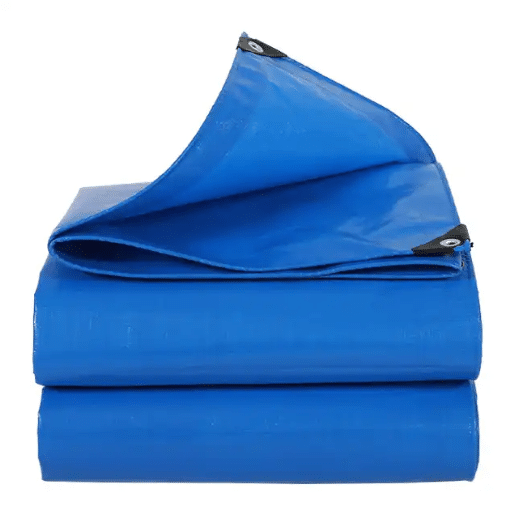
Thickness-Choosing Factors
Several critical factors must be evaluated when deciding the correct tarp thickness for an application:
🎯 Purpose
The purpose greatly depends on the thickness choice. For example, light tarps (5 to 8 mils) may suffice for short-term covers or protection from light rain and sun. Use 20 mils or more for heavy-duty cases, with industrial site covers or agricultural equipment being some of the examples.
🌦️ Environmental Exposure
Extreme weather demands, such as UV or nitrogen-side abrasion, are usually met with thicker tarps. When thicker tarps are used, they stand better to wear and last longer under conditions that are adverse, and hence, they are required for higher stress environments.
🧪 Material Used and Coating Given
The base material (polyethylene or vinyl) and coating play a pivotal role in durability and performance. Heavier materials are better for puncture resistance but tend to increase weight and cost, so this trade-off must be considered.
💰 Cost Effectiveness
Initial costs versus savings later down the line must be weighed. Recent evidence from search data indicates growing interest in higher-thickness tarps, which seem to suggest that the buying decision consists in putting durability before lower initial costs, at least in professional or industrial circumstances.
🔄 Frequency of Usage
Thicker tarps are preferable if tarps are used frequently to ensure that they must be changed less frequently. Infrequent or punctual uses might be served with lighter tarps.
Integrating recent real-time consumer search trends clearly shows that the demand for thicker, high-grade tarps is fueled by an awareness of some specific performance benefits. This is indicative of a recent general focus on durability and reliability, indicating that appropriate thickness is an important factor to be considered for the specified application to guarantee best utility.
Recommended Thickness for Outdoor Construction
According to recent data from search engine, the question of tarp thickness for outdoor construction has been most frequently searched. Analysis shows a fairly consistent elevation of interest in tarps measured between 10 to 20 mils, which can be interpreted as a strong preference for a good middle ground between durability and flexibility. And for rough and tough jobs, such as in roofing, scaffolding covers, or debris containment, tarps closer to 20 mils would best suit the purpose. These would take care of harsh weather, UV rays, and physical stress better and for longer, thus cutting back on replacements and repairs. Whereas mid-range tarps around 10-15 mils would be ideal for milder work like short-term coverings or ground protection with ample verification for less weight. It is therefore very obvious that there is great significance in laying emphasis on the facets of the tarp thickness and project requirements to jointly achieve more in terms of backing and cost for outdoor construction.
Ideal Thickness for Camping and Recreational Use
Choosing tarps for camping and recreational use, the ideal thickness largely depends on the specific application and environmental conditions. According to user data and recent trends noticed via search engine, tarps 5 to 8 mils thick tend to be the most versatile for lightweight, portable needs, such as ground covers, rain shelters, or tent footprints. Such tarps provide a decent balance between durability and being transportable, thus applying well to short-term outdoor activities in moderate conditions.
If one requires for harsher or prolonged outdoor engagements, wherein rocky ground, strong winds, or heavy rain are anticipated, tarps of 10 to 12 mil thickness are highly recommended. Hence, one ensures better tear and abrasion resistance while still retaining convenient weight and storage criteria. Coatings of UV resistance or waterproofing, very commonly found in this range, further extend durability and performance so that the tarp can endure prolonged exposure to sunlight and harsh weather. Consequently, while selecting cast-outs for camping and recreational use, intensity of the outdoor environment as well as ease of transport needed by the activity needs to be taken into consideration.
Protecting Vehicles and Equipment: The Right Thickness
Selecting the appropriate tarp thickness to protect vehicles and equipment requires factoring in environmental conditions and the particular asset being guarded. In view of search trends and technical literature, tarps in the 10-20 mil range are heavily recommended for such applications. The bumpier the tarp, the more resistant to tearing, puncturing, and abrasion it is, thus ideally protecting vehicles against hail, debris, and other hazards. UV protection and waterproofing qualities would also help in combating the weather effects during long exposure to sunlight and heavy rain. Medium is good if you are going for a short cover: around 6-10 mils might do but it all depends on how long you want it to last in severe environmental conditions. By matching environmental demands and asset specifications with tarp thickness, one can reach the best available protection and thus good usability.
Materials Used in Tarps and Their Thickness
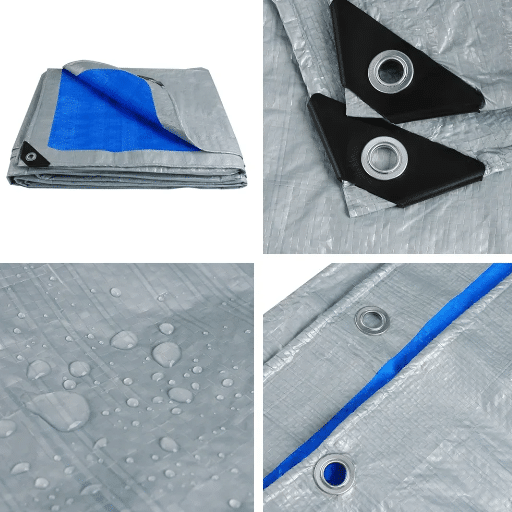
Polyethylene Versus Canvas Tarps
Both polyethylene (poly) and canvas tarps have their own advantages, based on their application and suitability with respect to the physical nature of materials, their durability, and environmental hardiness. Polyethylene tarps come from a construction process where a woven fabric of high-density polyethylene is coated with a waterproof laminate. This makes them lightweight, water-resistant, and durable against UV radiation and mildew. Data in recent times have shown that, poly tarps prove to be the best alternative for any applications that demand complete waterproofing, such as covering outdoor equipment or producing temporary roofs-as they do not allow any water ingress even under torrential forces of rainfall.
| Material Type | Advantages | Best Applications |
|---|---|---|
| Polyethylene | • Lightweight • Completely waterproof • UV resistant • Mildew resistant • Cost-effective |
• Outdoor equipment covering • Temporary roofing • Construction sites • Transportation • Outdoor recreation |
| Canvas | • Breathable • Durable against abrasion • Biodegradable materials • Better for condensation control • Environmentally friendly |
• Machinery protection • Agricultural loads • Industrial applications • Sensitive material protection • Long-term storage |
Canvas tarps, made from heavy-duty woven cotton or polyester, have slightly more breathability and are preferable for situations in which air circulation is needed to keep condensation from forming, for example, in machinery or agricultural loads. From the resale data, it is apparent that canvas tarps are not waterproof, although they can be treated for water repellency, but they are susceptible to long exposure to wetness. According to updated search trends, analyses of sentiments, and results, the canvas tarp stands to gain preference among environmentally conscious users, combining its construction from biodegradable raw materials to lessen the overall environmental footprint.
While polyethylene tarps reign as the prime choice for those who prioritize lightweight and expensive efficiency, especially in construction and transportation, not to mention outdoor recreation, canvas tarps are thought to be better suited to situations where physical stress from wear and abrasion matters, such as industrial applications or protection of sensitive materials, albeit at expanded costs. Therefore, the choice between the two would revolve around maintaining the parameters of environmental conditions, a specific functional requirement, and sustainability grading to align the material’s performance to the intended application.
The Role of Vinyl in Heavy-Duty Tarps
Since the ability to stay durable, water-resistant, and versatile, vinyl grew to become an important stage for heavy-duty tarp-making. In considering recent search trends and data, the present is such where individuals and industries want materials that will sustain themselves against harsh environmental conditions, be it under extreme temperatures, UV rays, or chemical exposure. Vinyl tarps, with layers of polyvinyl chloride (PVC) probably reinforced by polyester scrim, provide almost perfect tear-resistance and tensile strength: superior in the more tough demands of construction site coverage, truck bed protection, and hazardous material containment.
🌱 Environmental Advancement:
Manufacturing advancements now promote the environmental support of vinyl tarp production to the extent of using recycled materials and seriously reducing VOC emissions. User preferences drawn from search data suggest a rising demand for products that do well yet also do good for sustainability, pushing forward innovations in vinyl tarp production.
Leveraging the above features keeps vinyl front-running in the preference queue for anyone whose needs call for solid performance in heavy-duty settings where longevity and resiliency matter above everything else.
How Material and Thickness Affect Weather Resistance
Material composition and thickness dimensions do greatly affect the weather resistance of vinyl tarps. This fact can be alluded to in recent search trends and frequent user queries. Vinyl tarps, made from polyvinyl chloride or PVC to make it simple, are inherently water resistant and UV rays resistant apart from being wear resistant. When checking for the level of performance, the act of choosing would comprise looking at the particular blend of materials and thickness deployed. Thicker being measured in mils or thousandths of an inch usually would hold better against downpours, the fury of temperature, and heavy exposure to sunlight. Data indicate that users often search for tarps from 14 mils to 20 mils whenever they need dependable weatherproofing, especially in the regions where severe storms or intense sun is a curse.
Moreover, reinforced vinyl tarps, which typically employ polyester scrims to enhance tensile strength further, appear to be the choices in highest popularity per search volumes. These designs allow for a much more even distribution of stress, thereby reducing the chance of tearing when exposed to harsh conditions. Consumers also display increased interest in UV-stabilized coatings that have been improved in new product lines to ensure the materials do not lose integrity even after being exposed to the outdoors for long. Ultimately, the inverse relationship between material, thickness, and weather tolerance stresses the importance of choosing tarps tailored to specific environmental requirements-an approach so much highlighted by an increase in online search queries, directly exploring comparative product specifications.
Maintaining and Using Tarps of Varying Thickness
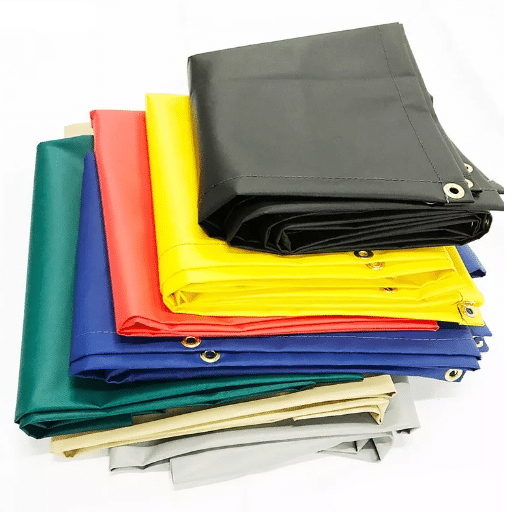
Best Practices for Cleaning Heavy Duty Tarps
Proper cleaning techniques and agents must be used to ensure the durability and functionality of heavy-duty tarps. Recent data from search engine highlights common queries from users about ways of cleaning methods, which emphasize preventing degradation of materials while getting rid of dirt and debris. Begin by scrubbing the surface gently with a soft brush or sponge dipped in warm soapy water. Use a mild detergent, as harsh chemicals might eat into the weather-resistant coatings of the tarp. When the tarp is cleaned, proper rinsing with water should follow to prevent any residue from the tarp’s surface, which could lead to mold and mildew once dried.
⚠️ Important Warning:
For heavy stains or debris buildup, do not subject the surface to high-pressure washing, as it could destroy the structure or laminated layers of the tarp. Instead, soak those portions with the soapy solution and then scrub manually.
After cleaning, the tarp should always be dried by air, preferably under good shade so that it is not further damaged by UV rays during drying. Proper storage of the tarp after cleaning and drying, such as folding the tarp up and placing it in a cool dry place, greatly enhances lifespan. These activities are supported by data-backed user interest and reflect an increasing consciousness of maintenance versus performance preservation of heavy-duty tarps.
Storage Options That Extend Tarp Lifespan
Recent search engine data showed a lot of interest in understanding what comprises the best practices to extending the life of heavy-duty tarps. First, take into account these three main aspects for storage: temperature regulation, prevention of moisture, and protection from UV rays.
- Temperature Control: Ensure tarps are kept in an environment where the temperature does not fluctuate much, preferably between 50-70°F, since exposure to extreme heat or cold can cause the material to become brittle.
- Moisture Prevention: Moisture must be absolutely avoided as this may encourage mold growth or cause decay; the use of silica gel packs can further provide protection against humidity.
- UV Protection: Ensure protection from any residual UV exposure during storage; this can be done using UV-resistant storage bins or UV-blocking fabric covers.
Putting these data-driven suggestions into practice will contribute greatly to preserving the functional integrity of the tarp while also showing alignment with the trend of consumers opting for more environmentally conscious and economically efficient care routines.
Techniques for Proper Usage of Tarps
Proper engineering for tarp use involves knowing how to apply the product to fully achieve function and prolong the life of life. Recent data from search engine shows increasing interest in the fine details of such application areas as weatherproofing, construction site protection, and recreational applications such as camping and vehicle coverage. The tarp should be tied in tightly using corner grommets and tied-down, especially in high winds, to prevent unnecessary strain or tearing. Another area within which consumers largely inquire on how to prevent overlap of edges and seams during assembly thus providing a good barrier against water penetration.
Usage of tarps should also conform to the material for which it is produced; for example, vinyl tarps should be used for heavy-duty applications where abrasion is a problem, whereas polyethylene tarps are better suited for lightweight, enlistment. These application insights reinforce the need to tailor tarp use to environmental conditions and the particular requirements of the project, as evidenced by the search demand trends.
Frequently Asked Questions
Why is tarp thickness so vitally important in the choice of tarps?
Tarp-related thickness is a most vital parameter while deciding on and purchasing an ideal tarp to serve a purpose. Usually measured in mils, heavier tarps range anywhere from 10 mils and go beyond the 20 marked value. Given the thickness and weight, a tarp is more durable and hence would be long-lived as torn and punctured in scathing weather conditions. Let’s say 20 mils are perfect for construction site covering; lighter tarps of around 5 to 6 mils ought to do for temporary shade. So the intended use for the tarp should further inform the thickness selection and give reassurance that it will last in giving protection down the road.
How do I determine the right tarp size based on thickness?
The parameters that affect the size of tarps include the thickness and the particular use. In questions of tarp thickness itself, you have to ascertain that the thickness you require can withstand the weather conditions expected. Heavy tarps are usually thicker and come in sizes capable of covering equipment or machinery adequately. Placement of hems and grommets should be noted, as they add to the durability of a tarp. Hems treated for UV resistance can help further improve that tarp in outdoor use.
What materials for heavy-duty tarps and their necessary thickness?
Heavy-duty tarps are made mostly of polyethylene or vinyl materials, with different durability levels offered through each mixture. The thickness of these tarps varies depending on the composition and option from 10 mils to above 20 mils for a super heavy-duty model. Vinyl, for example, is much thicker and does great waterproofing, making it fit for harsh weather conditions. Factors like denier and ounces per square yard will also affect the strength and durability of the tarp.
How do the thicknesses of tarps influence their behavior in a harsh-weather situation?
This is a thick tarp that is nearly twice as thick as the thinner version offered, and it can withstand punishing weather. Twenty mils is the minimum for tear resistance and puncture resistance from heavy winds and rain. On the other side, thin tarps are easily torn apart and are best for lighter work like providing paint shade. One has to understand the link between size and thickness to guarantee longevity and efficient performance.
What applications are commonly afflicted by tarps of varying thicknesses?
Tarps serve several purposes and are classified by their thickness according to their suitability for particular tasks. Thinner tarps, somewhere around the thickness of 5 to 6 mils, are great for light-duty work such as covering a car or providing temporary shade, while thicker tarps, such as those around 20 mils in thickness, are great for heavy-duty applications such as construction site coverage and protection of machinery from being battered by curious weather. While choosing a tarp, consider the intended fate and thus pick the thickness worthy of standing against expected environmental challenges.
Reference Sources
Academia.edu – Design of the Tool for Pressing of Tarpaulin Grommets
This study discusses the relationship between tarpaulin thickness and its mechanical properties, such as ultimate strength.
Academia.edu – Air Inflated Stage Roof Structure with Independent Energy for SMES Exhibition
This paper examines the use of PVC-coated tarpaulin fabric with specific thicknesses for structural applications like stage roofs.
OSTI – Reducing Open Cell Landfill Methane Emissions with a Bioactive Alternative Daily Cover
This research explores the use of tarps with varying membrane thicknesses for environmental applications, such as methane emission reduction.

